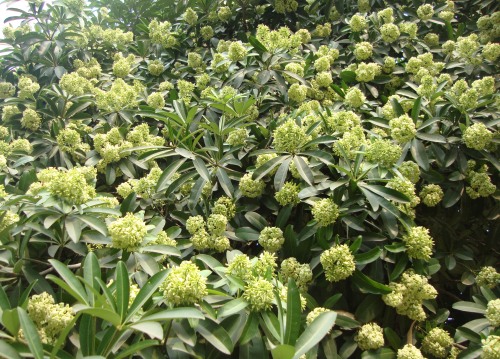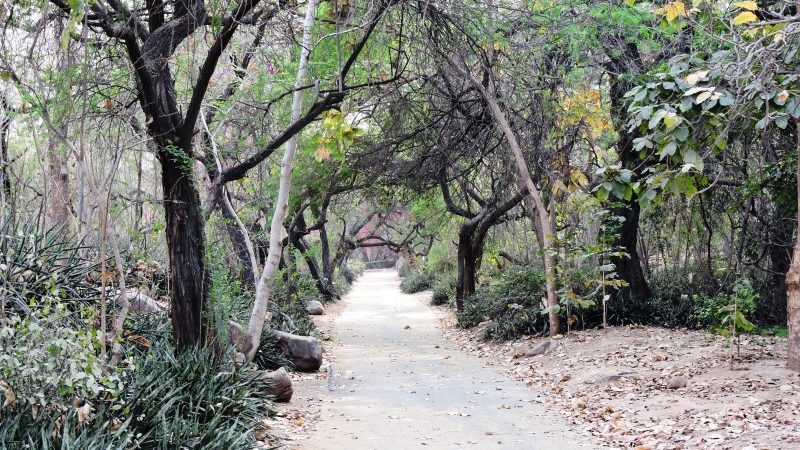What’s that October devilish smell, Delhi?

It’s the October Delhi evening and you are walking briskly along a tree lined road amidst the hustle and bustle of city life. Suddenly a somewhat confusing smell attracts your senses. The smell is strong and diverts all the chaos in your head and fully captures your attention. Memorable yet not so sweet, the smell makes you pace up a little, for something tells you you shouldn’t be under its spell for long.
But you’ve only gone a few steps ahead that the now fading but still enchanting smell makes you stop and look back. And you perhaps take a few steps back in an attempt to experience the mesmerizing smell once again! If you live in a colony blessed with trees, especially in the Lutyen’s part of Delhi, chances are that this smell is also entering your balconies and gardens each evening.
This characteristic Delhi winter smell that announces and welcomes the Dilli ki sardi (Delhi’s winter), emanates from Alstonia scholaris or the Scholar’s tree, belonging to the category of evergreen trees or shrubs with white funnel-shaped flowers and a milky sap.
A native of Indo-Malayan region, the genus is named after Professor C. Alston, a famous botanist of Edinburgh. The species has its origin in its use for making students’ black boards or slates. It is an ideal shady, easy to grow tree which is known to help control noise pollution in urban settings.
Ayurveda finds the uses of Alstonia as a bitter and astringent herb for treating skin disorders, malarial fever, urticaria, chronic dysentery, diarrhea, in snake bite and for upper purification process of Panchakarma. Its bark, known as Dita Bark, is used in traditional medicine to treat dysentery and fever.
The tree gives a very elegant look all year round and is therefore gaining popularity with landscape architects and gardeners across North India. Called Saptparni or the Shaitan Tree (Indian Devil Tree), the tree is reported to be grown across the country and in the Western Ghats, tribal people are reluctant to sit or pass under this tree, for the fear of the devil.
The tree has indeed given Delhi its characteristic smell that many in the city can now relate to. And those who come into the city from outside can find something to relate to. For the identity crisis hit Delhi, that is still struggling with a stakeholder crisis of a megalopolis magnitude, this could only be a good thing.




This is very common in Mumbai now and is a perfect compliment to onset of winter. WE have always called this flower as “Spicy Rani” . Something like raatrani that booms in the night. Fragrance of Saptparni is sweet with a tinge of spice and nothing beats the name SpicyRani.. a perfect companion for lovers in winter!!
Thanks for understanding this mesmerizing tree. We have few near our campus. These trees prompt me to walk longer. It’s blessing of mother nature. My wife wants to plant it near our house.For me, Saptparni is the tree of paradise.
Thank you for mentioning this I’ve always looked for the name of this tree. Ilove it’s fragrance and very few take out the time to mention this. Thank you again 🙂
so it is true no matter whatbh want to find you find on google … i ended up here thinking of this fragrance though it attracts, but in the basis of the comments above i am confuse weather it is good or bad for human health?
wheather to or not to sumit under this tree during night? ( not cause of devil etc) but considering co2 emision in mind
Extremely apt description of this enchanting tree!!
I now live in Mumbai,and came across this tree in my late evening walk. Especially as it is a full moon night the experience was absolutely magical… The smell, the soft breeze and the warm moonlight.
And like you pointed out, it transported me to growing up days, and happiness coursed through me 🙂
These trees grew in our garden in Hyderabad as well as when we were in Delhi.
Thanks!!
This tree blossomed at IITM, Pune campus. Giving beautiful sweet fragrance, every time it fastened me whenever I cross it.
I think there is a connection between what Barbara Mahajan says about her daughter’s asthmatic allergy to the pollens of this tree and the name ‘Shaitan Tree’ used by the tribal people. At the peak of flowering even a normal person can feel the overpowering nature of the scent at night. Maybe that the tribal people also developed asthmatic allergies and that might be the reason why they do not like sit under this tree.
The name ‘Saptparni’ is perhaps based on the cluster leaves of this tree, which has seven petals/sections
I have a few of these lovely trees which have grown to the level of my third floor balcony. Yes they announce winter with their mesmerising fragrance. One of these three trees however, flowers much in advance of course, partly and later slightly with the other two trees.
I have been fighting a lone battle against the invasion of Delhi by vilayati kikar, which is nothing but a weed that is endangering biodiversity in Delhi. (Australian Government for example, has banned it and provides incentives for its elimination).
I am at a loss how consecutive Delhi governments misrepresent infestation by prosopis juliflora as part of their great achievements in greening Delhi. If Delhi does not wake up and stop this infestation, it will soon lose whatever is left of its environment.
I feel vomit/nausea type of feel when I pass/smell this tree. Is any thing to note ?
I feel nauseated too.now it’s blooming in Bangalore and I can’t stand it.
I always wanted to know which tree is that who holds that amazing smell and finally I ended up here..☺
This is one of the main things I love so much about delhi! I’m originally from Bombay, so when I got married and moved to delhi .. this fragrance grabbed my senses .. you’re right, it’s almost intoxicating and makes you close your eyes and inhale the goodness it emanates. I love this time of the year as these blossom begin to say hello to our senses!
I was always wondering what this tree is called and on googling I stumbled upon your article .. didn’t realise there was an. Article dedicated to it 🙂 .. thanks!
Follow up
I am in love with the smell of this tree.living in eastern india it seems october month is the most happening month of the year(festivals+holidays+pause).it feels like homecoming after a hard year spent in the busy life and welcoming the winters.and the aroma excites you and increases love peace and happiness.I looked for the name of the tree for a looong time..finally found it..will grow one in area too.:)
Thank you for your article. I am native of Sindhudurg district in southern Maharashtra. My village is in the western ghats. There are many trees of Saptaparni in my village. I have a huge tree just near my house, flowers fall on our roof. We the villagers treat this tree as sacred. We dont cut it and it is treated as God’s tree, I am amazed to learn that this beautiful and medicinal tree is called Devils tree in north. This tree is very useful to us.
I love the scent of the blossoms, it is simply divine.
I am so fond of this typical Delhi winter fragrance that I used to miss it badly while I was in Bangalore for 8 years. Now since I am back I feel very awesome. It brings back old memories.
Wonderful article. This tree is just in front of our balcony and this article is so well written that every facts mentioned I can relate to. Great read.
Thanks
I agree, the fragrance is really mesmerizing but at the same time I too experience very similar conditions once I am near these trees (breathing problems and allergic reactions).I wanted to plant these trees but now I am in too thoughts after reading some comments here, as October is the most difficult month from health aspect for me too (: Is there a reliable research on this aspect?
I find its smell awesome and makes me nostalgic .
Please check if those are Alstonia trees or a different species (perhaps Pongamia). No pathogen causing plant disease is known to have a similar affect on humans, so don’t worry about that.
all allastonia trees surrounding my house have some diseases .whch is seen in the leaves ,something like chicken pox…pl advise wht to do..is this disease infectious to humans
wow… Beautiful…. lovely evening….
The pollen falls at night & in the morning there are
petals littering the ground. My daughter is very allergic
to the tree, probably the pollen and would always have
an asthma or bronchitis attack around her birthday which is the middle of October. Now she lives in California and seldom has breathing or coughing attacks.
During the flowering season of this tree i get cold, cough, bronchitis, sneezing, watery eyes, running nose. Its starts around 15 oct. And ends around 18 november. Problem stops automatically without any medication. But this one month becomes hell for me. I stay in delhi. If i can be of any help for ur scientific study m sharing my number. 9312150589